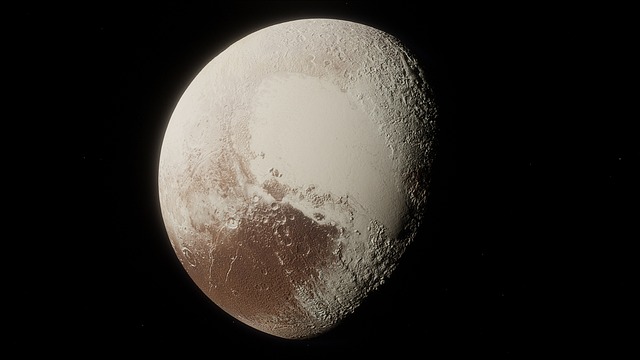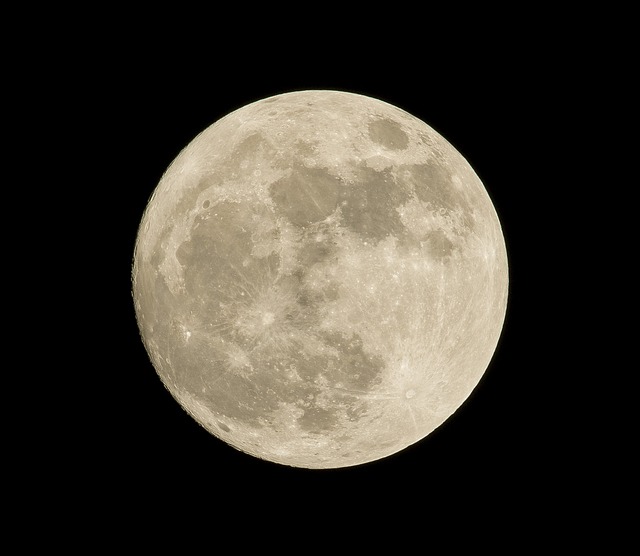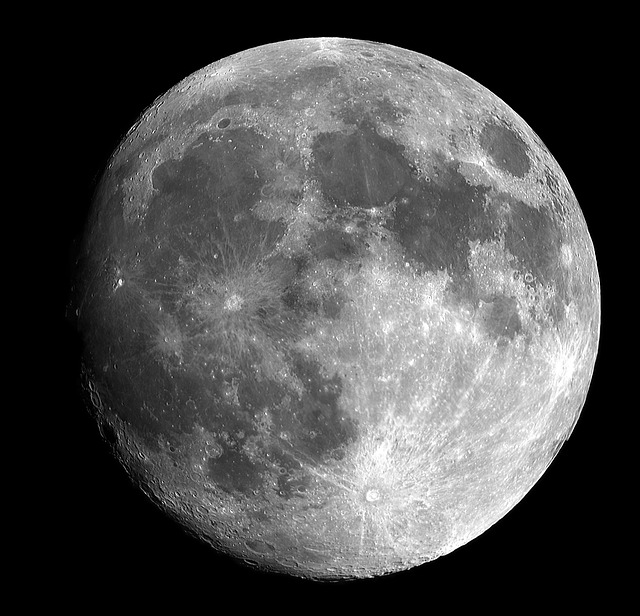Like a mysterious character in a cosmic narrative, Pluto has long held our fascination, captivating us with its elusive charm. This celestial body, shrouded in a cloak of astronomical intrigue, has been the subject of intense scrutiny and debate.
Once a fully-fledged member of our solar system’s planetary family, it was rechristened as a dwarf planet in 2006, instigating a wave of controversy.
As we embark on this journey through the cosmos, our mission is to delve deeper into the enigmatic world of Pluto. We aim to unravel the secrets it keeps hidden under its icy surface, shed light on its unique characteristics, and explore its captivating history.
With every layer we peel back, we’ll bring you closer to understanding the dwarf planet. So, tighten your celestial seat belts as we take a closer look at Pluto and its fascinating secrets.
History of Pluto
To comprehend the fascinating story of Pluto, we must first cast our minds back to the early 20th century. Despite the mighty leaps and bounds in the field of astronomy during this time, the outer reaches of our solar system remained shrouded in mystery. It was into this unknown that a young, determined astronomer named Clyde Tombaugh ventured, leading to one of the most significant discoveries of the era.

pluto
In the year 1930, Tombaugh, armed with his telescope at the Lowell Observatory in Arizona, noticed a moving object in the distance. This distant celestial body was later christened ‘Pluto’, named after the Roman god of the underworld, perfectly encapsulating the enigmatic and elusive nature of this new planet.
However, Pluto’s status as a planet would prove to be as transient as its visibility from Earth. Despite its discovery, the true nature of Pluto remained elusive for many years. The International Astronomical Union (IAU) initially classified it as the ninth planet of our solar system, but this status was to come under severe scrutiny and debate.
- The controversy stemmed from the discovery of several other objects in the Kuiper belt, a region of the solar system beyond the orbit of Neptune, which were comparable in size to Pluto or even larger. This raised questions about the validity of considering every such object a planet.
- The reclassification of Pluto as a dwarf planet in 2006 by the IAU was a decision met with shock and dissent from both the scientific community and the public. The IAU defined a planet as a celestial body that orbits the sun, is spherical in shape, and has cleared its orbit of other debris. Despite meeting the first two criteria, Pluto’s inability to clear its orbit led to its demotion.
Pluto, the former ninth planet of our solar system, was now the largest known dwarf planet in the solar system and the second-most-massive known object orbiting the sun directly in the Kuiper belt. Its fall from planetary status was a result of our evolving understanding of the cosmos, reminding us that science, like the universe itself, is ever-changing.
In spite of this reclassification, the history of Pluto remains a testament to human curiosity and our relentless quest to unravel the mysteries of the universe. This intriguing past sets the stage for future exploration, continuing to inspire researchers to delve deeper into the secrets of this enigmatic dwarf planet.
Physical Characteristics of Pluto
Pluto, often called the “dwarf planet”, boasts a rich tapestry of intriguing and distinctive physical characteristics. Its size, composition, and surface features, all contribute to the mysterious allure of this celestial body.
Starting with its size, Pluto is the largest dwarf planet in our solar system, but it’s still quite petite when compared to our own planet, Earth. With a diameter of about 2,372 kilometers, Pluto is roughly one-sixth the width of Earth. Imagine if Earth were the size of a basketball, Pluto would be no larger than a soccer ball in comparison.
Now, let us touch upon the composition of Pluto. The dwarf planet has a rocky core surrounded by a mantle of water ice, much like a candied apple is coated with a shell of sweet caramel. But don’t let this sweet analogy fool you, as the temperature on Pluto can drop to a bone-chilling minus 375 to minus 400 degrees Fahrenheit!
The outermost layer or ‘crust’ of Pluto is made up of nitrogen ice, methane, and carbon monoxide, all frozen solid due to the unforgiving cold of space.
Pluto’s surface features are known for their variety and complexity. The New Horizons spacecraft, which flew past Pluto in 2015, revealed a landscape peppered with mountains, valleys, and plains. These have been named after pioneers of exploration and mythological beings from different cultures. For instance, the expansive heart-shaped region, named Tombaugh Regio, is a vast plain of nitrogen and carbon monoxide ices.
- Pluto’s Orbit and Its Relationship with Charon: The dance between Pluto and its moon Charon is a fascinating aspect of the dwarf planet’s physical characteristics. Unlike most planet-moon systems, Pluto and Charon are gravitationally locked, endlessly pirouetting around each other in a cosmic ballet. This mutual tidal locking means that they always present the same face to each other, a phenomenon that is as enchanting as it is perplexing to astronomers.
- Other Moons: Pluto isn’t a lone wolf in the vast expanse of space. Orbiting Pluto are four smaller moons, namely Nix, Hydra, Kerberos, and Styx. These tiny moons, all irregularly shaped, add more intrigue to our understanding of Pluto’s system.
In the grand scheme of things, each of these physical characteristics sheds light on the intriguing world that is Pluto. From its size and composition, to its surface features and its system of moons, Pluto continues to mesmerize scientists and space enthusiasts alike, further fueling our curiosity about the infinite expanse of the universe.
Exploration of Pluto
The arena of space exploration has always been characterized by immense curiosity, a thirst for knowledge, and a daring spirit. Few celestial bodies have sparked the interest of scientists and astronomers like that of Pluto. This fascination is well-deserved, as exploration efforts have uncovered a myriad of captivating and unexpected features of this distant world.
The journey into Pluto’s myriad secrets began with the groundbreaking mission in 2015, the New Horizons. Launched by NASA, this mission was a significant milestone in our quest to understand the outer reaches of our solar system. It was the maiden voyage to the third zone of our solar system, the region populated by icy “worldlets” including none other than Pluto itself.
- The New Horizons Mission: This mission set a precedent in space exploration. Reaching Pluto after a 9-year voyage across the vast expanse of the solar system, New Horizons offered a close-up look at the dwarf planet. The mission’s findings were nothing short of astonishing. It revealed that Pluto has a complex and active geology, contradicting earlier theories that assumed it would be a dead, frozen world. The mission’s data has enriched our understanding of Pluto, and the findings continue to be analyzed today.
Not only did New Horizons unveil Pluto’s geology, but it also shed light on its atmosphere. The spacecraft found a thin but layered atmospheric haze, with compounds that cause it to glow in a blue hue. This was an unprecedented discovery, one that continues to intrigue scientists.
Despite the monumental success of the New Horizons mission, our understanding of Pluto remains in its infancy. The data collected has raised as many questions as it has answered, making it evident that further exploration is needed. The dwarf planet’s complex geology, atmospheric conditions, and multi-faceted moons are all areas that require continued research.
- Ongoing Data Analysis and Research: Scientists are still sifting through the wealth of data sent back by New Horizons. The data reveals intricate details about Pluto’s topography, including mountains, valleys, and plains. The exploration of Pluto is a thrilling testament to the spirit of discovery and the relentless pursuit of knowledge.
In conclusion, the exploration of Pluto has been, and continues to be, an exciting journey. As we look to the future, the potential for new missions and further research remains boundless. The quest to unravel Pluto’s mysteries is far from over, and the dwarf planet promises to continue captivating us with its secrets.
Secrets of Pluto’s Atmosphere
Traveling through the cosmos, far beyond Neptune’s orbit, we discover a world enveloped in an atmosphere as enigmatic as the dwarf planet itself: Pluto. Dwarfed in size but not in fascination, Pluto’s atmosphere is a marvel of celestial mechanics and chemistry, a testament to the unanticipated complexities of our universe.
Wrapped around the tiny, icy body, the atmosphere of Pluto is as thin as a wisp, often described as a ‘chemical haze’. It is predominantly composed of nitrogen, with traces of methane and carbon monoxide. These elements, simple as they may seem, orchestrate a symphony of phenomena that continue to intrigue scientists.
- Seasonal Changes: Pluto’s atmosphere undergoes significant seasonal changes. As Pluto orbits the Sun, a journey that takes an astonishing 248 years, its distance from the Sun varies, leading to dramatic shifts in temperature. When closest to the Sun, the surface ice sublimates, thickening the atmosphere. Conversely, as Pluto moves away, the atmosphere condenses and snows back onto the surface.
- Atmospheric Pressure: Despite being less than one millionth of Earth’s atmospheric pressure, Pluto’s atmosphere extends about 1,600 kilometers above the surface, creating a ‘pressure cooker’ effect that aids in maintaining its existence.
But how does Pluto’s elongated elliptical orbit and its extreme distance from the Sun affect its atmosphere? Well, the answer lies in a delicate balance of solar radiation and gravitational pull. Even though Pluto is located in the frigid outer realms of the solar system, a delicate but sufficient amount of sunlight reaches the surface, providing the energy necessary to maintain a gaseous atmosphere.
- The sun’s rays, though weak, evaporate the icy surface creating a thin, but detectable atmosphere.
- Pluto’s low gravity, about six percent of Earth’s, allows the atmosphere to extend far into space.
It’s a fragile equilibrium, and any significant changes in these parameters could dramatically alter Pluto’s atmospheric dynamics.
Presently, scientists are conducting ongoing research and formulating theories about the formation and evolution of Pluto’s atmosphere. The exploration mission ‘New Horizons’ provided a treasure trove of data, which is still being analyzed. It revealed the existence of distinct weather patterns, layers of atmospheric haze, and even clouds – revelations that have overturned previous assumptions and opened new avenues for exploration.
Unraveling the secrets of Pluto’s atmosphere is akin to solving a cosmic puzzle, a journey that presents more questions than answers. Yet, every discovery, every new understanding, uncovers a piece of the intricate tapestry that is our universe, illuminating not only the mysteries of Pluto but also the fundamental processes that drive the evolution of planetary atmospheres.
Mysteries of Pluto’s Surface
If you thought the surface of Pluto was just a stretch of icy landscape, be prepared for a surprise. Pluto’s terrain is a potpourri of mountains, plains, and craters, each with its touch of intrigue and mystery. Let’s attempt to unravel some of these mysteries.
The intricate surface of Pluto is a treasure-trove for astronomers, with a variety of terrains that keep them on their toes. The dwarf planet, much like a chameleon, keeps changing its appearance, unveiling new and exciting landforms.
- Mountains: Pluto’s mountains are colossal structures, rising several kilometers above the icy surface. Interestingly, these towering heights are seemingly formed of water ice, painting an image so alien to what we know of mountains here on Earth. The origin of these features still puzzles scientists.
- Plains: The plains of Pluto, also known as “Sputnik Planitia”, are another major surface feature. Unlike the rugged mountains, these plains are relatively smooth with a surface shaped by slow-moving icy flows, resembling Earth’s glacial movements. This icy sea is unique in our solar system, coaxing scientists to question its mysterious origin.
- Craters: The craters on Pluto are a testament to its violent history. These bowl-shaped depressions, formed by the impact of celestial bodies, vary in size and complexity. Unlike the moon, however, some of Pluto’s craters are curiously free of the usual marks of weathering and age, hinting at a complex geological history.
Comparisons between Pluto’s surface and other planetary bodies in our solar system have led to some notable contrasts and similarities. For instance, Pluto’s surface is largely unlike that of other planets in our solar system, with its nitrogen and methane ices. However, it also shares similar characteristics with Neptune’s moon Triton, like the presence of nitrogen ice and a strangely young-looking surface.
In the quest to decode the secrets of Pluto’s surface, ongoing research plays a significant role. Various theories about the formation, transformation, and significance of Pluto’s surface features continue to puzzle and amaze astronomers and scientists alike. This active research echoes the profound importance Pluto holds in our understanding of the outer solar system.
Pluto, the enigmatic dwarf planet, offers more than what meets the eye. Its surface, a canvas of cosmic art, narrates tales of a complex and intriguing past. As we continue to delve deeper into its mysteries, we can’t help but marvel at the wonders that lie on the distant frontier of our solar system.
The Future of Pluto
As we continue to peer into the whimsical world of Pluto, we are left with both a sense of awe and a hunger for deeper understanding. This enigmatic dwarf planet, nestled in the outskirts of our solar system, holds myriad secrets yet to unfurl. Despite its distance, the future of Pluto is anything but bleak; it is, in fact, a promising beacon for further exploration and research.
Space agencies worldwide, spurred by the captivating results of the New Horizons mission, have been contemplating proposed missions to further investigate Pluto. Some of these prospective voyages propose not just a fly-by, but a more detailed orbiter mission or even a lander. Just imagine the wealth of data and insights we could glean from the surface of this far-flung world!
- Continued Research
- As scientists continue to unpack the data from the 2015 New Horizons flyby, our understanding of Pluto’s dynamic geology, atmosphere, and moons continues to evolve. We are just beginning to scratch the surface of this world’s secrets.
- Future Missions
- While there are no immediate plans for another mission to Pluto, it remains an exciting prospect. Proposed missions include an orbiter that could study Pluto in more depth, or even a lander that could gather data from the planet’s surface.
- Potential for New Discoveries
- With the advent of new technology, the potential for uncovering new facets of Pluto is enormous. Its complex geology and unique atmosphere make it a rich target for study, and there are undoubtedly many discoveries yet to come.
Understanding Pluto’s place in the solar system is crucial. Not only does it provide us with a glimpse into a part of the solar system we are less familiar with, but it also sheds light on the origins of our own world. The more we unearth about Pluto, the more we learn about the birth and evolution of planets, including Earth.
While we may not have all the answers yet, we are slowly piecing together the cosmic puzzle that is Pluto. The exciting future of Pluto is not only about exploring the unknown but also about refining and redefining what we think we know. As we delve deeper into Pluto’s mysteries, we are reminded of the value of scientific exploration and the never-ending quest for knowledge.
Pluto, the underdog of our solar system, has proven time and time again to be a treasure trove of surprises and scientific revelations. Its future is as bright as a star in the night sky, promising a journey of astronomical proportions, filled with discovery, wonder, and the thrill of exploration.


